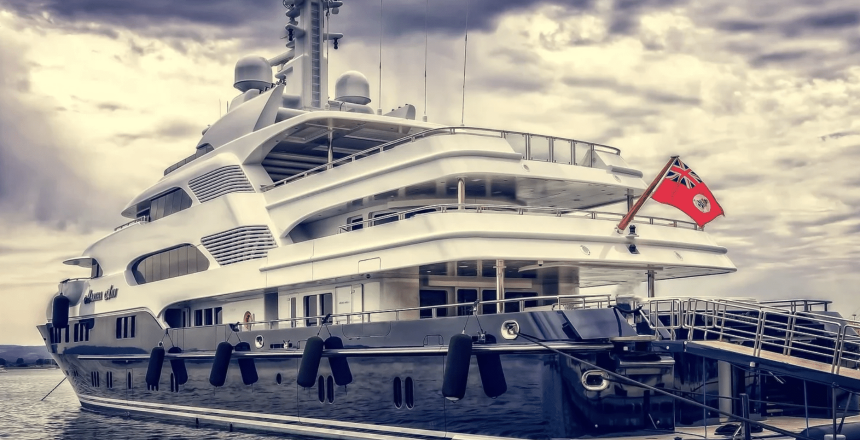Yacht classifications, also referred to as classification societies or class societies the that rules are an integral element of owning a yacht and an important part of maritime safety. These classifications dictate the design, construction and ongoing maintenance of large commercial vessels and superyachts.
The classifications provide highly detailed and technical standards which cover the yacht’s hull, its engines, and key safety systems. Naturally technology is constantly advancing and so new safety features and procedures are frequently evolving to cater for this.

Standard Yacht Types
Yachts are typically segmented based on overall length and how many passengers they can accommodate. The standard yacht classification types are large yachts, sailing yachts, commercial yachts and private yachts.
Commercial yachts are those yachts which engage in commercial activities, i.e charter yachts. These yachts do not transport or carry any cargo and can carry no more than 12 passengers when underway. In contrast, private yachts are typical pleasure vessels used solely for recreational or leisure purposes.
Classification society
Classification societies are organizations which ‘set the rules’ that govern the construction, maintenance, and operation of yachts and vessels. Currently, there are a total of 12 members of the International Association of Classification Societies, of which the main societies involved with yachting are::
- ABS (American Bureau of Shipping)
- Bureau Veritas
- DNV
- Lloyds Register
- Class NK
- RINA (Royal Institution of Naval Architects)
Classification societies were first started when insurance underwriters Lloyds of London set standards for the ships that they would ensure.
What is a flag state?
A vessel’s flag state is the jurisdiction or nationality under whose laws the vessel is registered or licensed.
The flag state has the authority and the responsibility to create regulations for vessels registered under its flag. These typically involve those relating to the inspection, certification, and issuance of safety and pollution prevention documents for the vessel.
Different flag states may perform inspections on the safety aspects of yachts using their own inspectors or use classification societies or other recognised organization to perform these inspections.
I have written a separate blog post which goes into further detail on Flag States and the importance of choosing the right flag for your yacht.

What is the classification process?
The first step of classification involves the assessment of a yachts design and regular inspections during the construction or conversion of a yacht. Once it is confirmed that all standards have been met, a certificate of classification is issued.
The certificate details the standard met, the intended use for the vessel, and whether the vessel should be used only in sheltered waters. The certificate is aevidence evidence that the yacht has been built too and meets industry standards.
In order to maintain classification regular surveys of the yacht are required. These surveys typically take place every 5 years. These surveys assess things such as the thickness of the hull, possible fractures, and other potential damage. They also consider the condition of electrical systems, machinery and equipment.
Mandatory Classification Certificates
There are a variety of different classification certificates. The number and type of mandatory certificates for a given yacht will depend on its size.
International Tonnage Certificate
This expresses the internal volumes of the yacht in gross tonnes. Unlike displacement tonnage, this does not quantify the weight of a vessel.
Large Yacht Code Certificate
This certificate covers navigational and signaling equipment, life saving appliances, fire protection, means of escape, and manning and crew accommodation. `
Class Certificate
This mainly deals with the yacht’s hull, machinery, electrical equipment, and outfitting.
International load line certificate
This certificate covers the weather tightness of the yacht
Safety Radio Certificate
This certificate only applies if the yacht’s gross tonnage exceeds 300GT. It covers radio communication and distress installations.
MARPOL Annex I Certificate
This certificate only applies if gross tonnage exceeds 400GT and covers the disposal of oil and bilge water
MARPOL Annex IV Certificate
This certificate only applies if gross tonnage exceeds 400GT or if the yacht is certified to carry more than 15 people and covers the disposal of sewage from ships
Marpol Annex V
This certificate covers the disposal of rubbish and applies to all ships
Marpol Annex VI
This is applicable if gross tonnage exceeds 400GT as well as to all main and auxiliary engines with a power exceeding 130kW. It concerns the emissions from mains and auxiliary engines (NOx and SOx). Safety Construction and Safety Equipment
These cover machinery, electrical parts, life saving and navigational equipment for yachts with a gross tonnage above 500GT. International Safety Management Certificate
This only applies to yachts with a gross tonnage greater than 500GT. A certified management company is requested to carry out this service, preparing operational manuals, procedures for drills, and taking care of the maintenance of the yacht and its installations. International Ship and Port Security Certificate
This only applies to yachts and ships with a gross tonnage greater than 500GT and covers the anti piracy certification. A certified management company is requested to provide ashore assistance and establish onboard procedures and operational manuals.
SALT Superyachts – Your Trusted Partner For Your Superyacht Journey. Offering you an unbiased and comprehensive yacht charter and yacht sales consultancy. www.salt-superyachts.com
+44 2038 821 364
